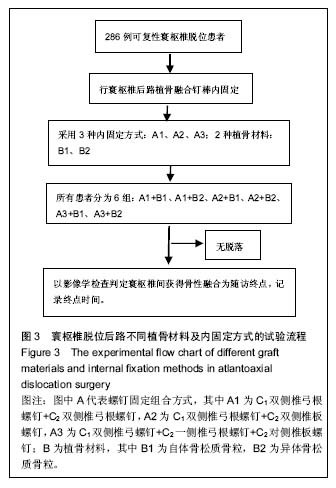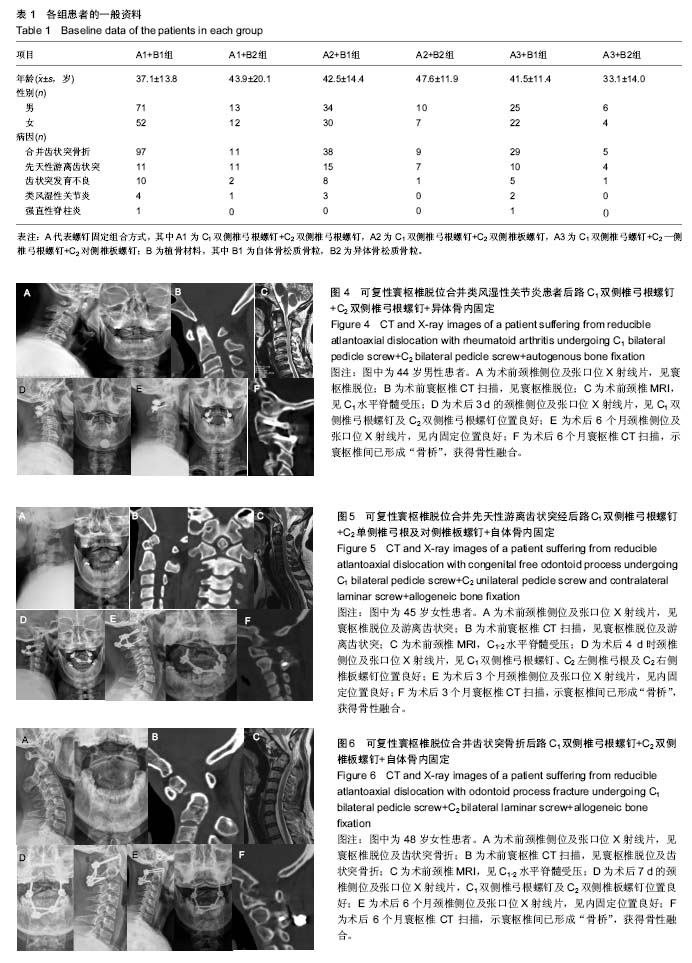| [1] Yin QS, Wang JH. Current Trends in Management of Atlantoaxial Dislocation. Orthop Surg. 2015;7(3):189-199. [2] Xu J, Yin Q, Xia H, et al. New clinical classification system for atlantoaxial dislocation. Orthopedics. 2013;36(1):e95-100. [3] 马向阳,尹庆水,吴增晖,等.多种寰枢椎后路钉棒固定技术的临床组合应用[J].中国骨科临床与基础研究杂志, 2010,2(1): 12-16.[4] Huang DG, Hao DJ, He BR, et al. Posterior atlantoaxial fixation: a review of all techniques. Spine J. 2015;15(10):2271-2281. [5] Richter M, Schmidt R, Claes L, et al. Posterior atlantoaxial fixation: biomechanical in vitro comparison of six different techniques. Spine (Phila Pa 1976). 2002;27(16): 1724-1732.[6] Meyer B, Kuhlen D. Atlantoaxial fusion: transarticular screws versus screw-rod constructs. World Neurosurg. 2013;80(5): 516-517. [7] Chiaramonti BC, Kim SY, Marchese LR, et al. Tomographic correlation for Magerl's technique in C1-C2 arthrodesis in children. Acta Ortop Bras. 2013;21(5):255-257. [8] Sim HB, Lee JW, Park JT, et al. Biomechanical evaluations of various c1-c2 posterior fixation techniques. Spine (Phila Pa 1976). 2011;36(6):E401-407. [9] Claybrooks R, Kayanja M, Milks R, et al. Atlantoaxial fusion: a biomechanical analysis of two C1-C2 fusion techniques. Spine J. 2007;7(6):682-688. [10] Melcher RP, Puttlitz CM, Kleinstueck FS, et al. Biomechanical testing of posterior atlantoaxial fixation techniques. Spine (Phila Pa 1976). 2002;27(22):2435-2440.[11] Park J, Scheer JK, Lim TJ, et al. Biomechanical analysis of Goel technique for C1-2 fusion. J Neurosurg Spine. 2011; 14(5):639-646.[12] Stulik J, Vyskocil T, Sebesta P, et al. Atlantoaxial fixation using the polyaxial screw-rod system. Eur Spine J. 2007;16(4): 479-484. [13] Guo SL, Zhou DB, Yu XG, et al. Posterior C1-C2 screw and rod instrument for reduction and fixation of basilar invagination with atlantoaxial dislocation. Eur Spine J. 2014; 23(8):1666-1672. [14] Qi L, Li M, Zhang S, et al. C1-c2 pedicle screw fixation for treatment of old odontoid fractures. Orthopedics. 2015;38(2): 94-100. [15] Harms J, Melcher RP. Posterior C1-C2 fusion with polyaxial screw and rod fixation. Spine (Phila Pa 1976). 2001;26(22): 2467-2471.[16] 马向阳,尹庆水,吴增晖,等.寰枢椎后路四种钉棒固定方法的三维稳定性评价[J].中国脊柱脊髓杂志,2008,18(6):464-468.[17] He B, Yan L, Xu Z, et al. Prospective, Self-controlled, Comparative Study of Transposterior Arch Lateral Mass Screw Fixation and Lateral Mass Screw Fixation of the Atlas in the Treatment of Atlantoaxial Instability. J Spinal Disord Tech. 2015;28(7):E427-432. [18] 马向阳,杨进城,邱锋,等.寰枢椎脱位后路植骨材料的选择与融合效果评价[J].中国骨科临床与基础研究杂志,2015,7(1):5-9.[19] Tan M, Jiang X, Yi P, et al. Revision surgery of irreducible atlantoaxial dislocation: a retrospective study of 16 cases. Eur Spine J. 2011;20(12):2187-2194.[20] Hwang IC, Kang DH, Han JW, et al. Clinical experiences and usefulness of cervical posterior stabilization with polyaxial screw-rod system. J Korean Neurosurg Soc. 2007;42(4): 311-316. [21] Bhowmick DA, Benzel EC. Posterior atlantoaxial fixation with screw-rod constructs: safety, advantages, and shortcomings. World Neurosurg. 2014;81(2):288-289. [22] Elliott RE, Tanweer O, Boah A, et al. Outcome comparison of atlantoaxial fusion with transarticular screws and screw-rod constructs: meta-analysis and review of literature. J Spinal Disord Tech. 2014;27(1):11-28.[23] 胡勇,徐荣明,董伟鑫,等.寰枢椎后路切开复位内固定术治疗陈旧性齿突骨折伴C1,2不稳症[J].脊柱外科杂志,2014,12(3):138-142.[24] 李菊根,黄彦,杨进顺,等.寰枢椎后路短节段个体化内固定治疗上颈椎损伤[J].中华创伤杂志,2013,29(6):519-522.[25] Ma XY, Yin QS, Wu ZH, et al. Anatomic considerations for the pedicle screw placement in the first cervical vertebra. Spine (Phila Pa 1976). 2005;30(13):1519-1523.[26] Menger RP, Storey CM, Nixon MK, et al. Placement of C1 Pedicle Screws Using Minimal Exposure: Radiographic, Clinical, and Literature Validation. Int J Spine Surg. 2015;9: 43.[27] 何帆.寰椎椎弓根形态分类与椎弓根螺钉固定的解剖学及生物力学研究[D].广州:南方医科大学,2006.[28] Hu Y, Dong WX, Spiker WR, et al. An anatomic study to determine the optimal entry point, medial angles, and effective length for safe fixation using posterior C1 lateral mass screws. Spine (Phila Pa 1976). 2015;40(4):E191-198. [29] Yin YH, Yu XG, Qiao GY, et al. C1 lateral mass screw placement in occipitalization with atlantoaxial dislocation and basilar invagination: a report of 146 cases. Spine (Phila Pa 1976). 2014;39(24):2013-2018. [30] Mummaneni PV, Lu DC, Dhall SS, et al. C1 Lateral Mass Fixation: A Comparison of Constructs. Neurosurgery. 2010; 66(suppl_3):A153-A160.[31] 夏虹,钟世镇,刘景发,等.寰椎侧块后路螺钉固定的可行性研究[J].中国矫形外科杂志,2002,10(9):888-891.[32] Ma J, Tang J, Wang D, et al. Comparison of perpendicular to the coronal plane versus medial inclination for atlas pedicle screw insertion: an anatomic and radiological study in human cadavers. Int Orthop. 2016;40(1):141-147.[33] Xu R, Bydon M, Macki M, et al. Biomechanical impact of C2 pedicle screw length in an atlantoaxial fusion construct. Surg Neurol Int. 2014;5(Suppl 7):S343-346. [34] Ma W, Feng L, Xu R, et al. Clinical application of C2 laminar screw technique. Eur Spine J. 2010;19(8):1312-1317. [35] Singh B, Cree A. Laminar screw fixation of the axis in the pediatric population: a series of eight patients. Spine J. 2015; 15(2):e17-25. [36] Su BW, Shimer AL, Chinthakunta S, et al. Comparison of fatigue strength of C2 pedicle screws, C2 pars screws, and a hybrid construct in C1-C2 fixation. Spine (Phila Pa 1976). 2014;39(1):E12-19. [37] Ma XY, Yin QS, Wu ZH, et al. C1 pedicle screws versus C1 lateral mass screws: comparisons of pullout strengths and biomechanical stabilities. Spine (Phila Pa 1976). 2009;34(4): 371-377. [38] Lehman RA Jr, Dmitriev AE, Helgeson MD, et al. Salvage of C2 pedicle and pars screws using the intralaminar technique: a biomechanical analysis. Spine (Phila Pa 1976). 2008;33(9): 960-965. [39] 马向阳,尹庆水,吴增晖,等.枢椎椎板螺钉与椎弓根螺钉抗拔出强度的比较[J].中国脊柱脊髓杂志,2007,17(2):137-139.[40] Dmitriev AE, Lehman RA Jr, Helgeson MD, et al. Acute and long-term stability of atlantoaxial fixation methods: a biomechanical comparison of pars, pedicle, and intralaminar fixation in an intact and odontoid fracture model. Spine (Phila Pa 1976). 2009;34(4):365-370. [41] 邓淼,权正学,罗小辑,等.寰枢椎椎弓根螺钉治疗寰枢椎不稳及脱位的临床效果[J].创伤外科杂志,2016,18(1):28-31.[42] 王正雷,孙鹏,张文进,等.后路寰枢椎椎弓根螺钉固定治疗创伤性寰枢椎不稳的临床研究[J].解放军医学杂志, 2015,40(9): 754-757.[43] 陈浩贤,昝中学,樊强,等.经寰枢椎椎弓根内固定治疗可复性寰枢椎不稳[J].临床骨科杂志,2016,19(4):408-410.[44] 左春光,王新虎,王建顺,等.寰枢椎椎弓根螺钉固定治疗寰枢椎失稳[J].中国脊柱脊髓杂志,2009,19(11):877-878.[45] Tubbs RS, Granger A, Fisahn C, et al. The Vertebral Artery Cave at C2: Anatomic Study with Application to C2 Pedicle Screw Placement. World Neurosurg. 2016;94:368-374.[46] Ra IH, Min WK. Vertebral arteriovenous fistula following C2 pedicle screw fixation. Spine J. 2013;13(10):1413-1414.[47] Yeom JS, Buchowski JM, Kim HJ, et al. Risk of vertebral artery injury: comparison between C1-C2 transarticular and C2 pedicle screws. Spine J. 2013;13(7):775-785. [48] Wang J, Xia H, Ying Q, et al. An anatomic consideration of C2 vertebrae artery groove variation for individual screw implantation in axis. Eur Spine J. 2013;22(7):1547-1552. [49] Neo M, Sakamoto T, Fujibayashi S, et al. The clinical risk of vertebral artery injury from cervical pedicle screws inserted in degenerative vertebrae. Spine (Phila Pa 1976). 2005;30(24): 2800-2805.[50] Yoshida M, Neo M, Fujibayashi S, et al. Comparison of the anatomical risk for vertebral artery injury associated with the C2-pedicle screw and atlantoaxial transarticular screw. Spine (Phila Pa 1976). 2006;31(15):E513-517.[51] 唐晓军,曹奇,陈亮元,等.枢椎椎弓根螺钉进钉点及植钉方式的解剖研究[J].中国修复重建外科杂志,2015,29(2):175-178.[52] Savage JG, Fulkerson DH, Sen AN, et al. Fixation with C-2 laminar screws in occipitocervical or C1-2 constructs in children 5 years of age or younger: a series of 18 patients. J Neurosurg Pediatr. 2014;14(1):87-93. [53] Park JS, Cho DC, Sung JK. Feasibility of C2 translaminar screw as an alternative or salvage of C2 pedicle screws in atlantoaxial instability. J Spinal Disord Tech. 2012;25(5): 254-258. [54] Sinha S, Jagetia A, Shankar R. C2 intralaminar (crossing/ipsilateral) fixation as a bailout procedure for failed transpedicular/pars interarticularis screw placement. Acta Neurochir (Wien). 2012;154(2):321-323. [55] Lehman RA Jr, Dmitriev AE, Wilson KW. Biomechanical analysis of the C2 intralaminar fixation technique using a cross-link and offset connector for an unstable atlantoaxial joint. Spine J. 2012;12(2):151-156. [56] 高延征,邢帅,高坤,等.枢椎椎板螺钉固定与枢椎椎弓根螺钉固定对枕颈融合术临床疗效的影响[J].脊柱外科杂志, 2016,14(3): 129-134.[57] 马维虎,胡勇,孙绍华,等.枢椎椎板螺钉治疗上颈椎不稳的临床研究[J].中国骨与关节外科,2009,2(6):459-464.[58] 钱列,劳立峰,刘祖德.枢椎椎板螺钉在上颈椎后路固定术中的应用[J].脊柱外科杂志,2016,14(6):321-324.[59] 马向阳,尹庆水,吴增晖,等.枢椎椎板螺钉联合寰椎椎弓根螺钉固定治疗寰枢椎脱位[J].中国骨与关节损伤杂志, 2009,24(3): 193-195.[60] He X, Meng Y, Zhang J, et al. Bone grafting of atlantoaxial joints and occipitocervical or atlantoaxial fusion for the reduction and fixation of basilar invagination with atlantoaxial dislocation by a posterior approach: a preliminary study. World Neurosurg. 2017. in press. |
.jpg)



.jpg)
.jpg)